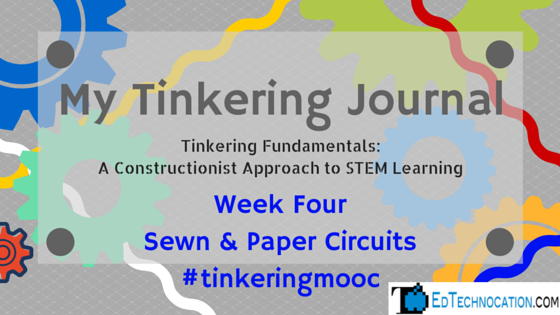For week four of the Tinkering Fundamentals online course we explored sewn and paper circuits. I found out this week that I hate sewing. More specifically, I hate threading a needle. But I enjoyed creating a paper circuit!
 |
| SparkFun on Flickr |
We also heard from MIT grad student, Jei Qi, who specializes in creating works of art with sewn and paper circuits. One of her projects that I'm really fascinated with is her Input/Output Self-Folding Paper that uses shape memory metal. This specialized metal, called Nitinol, remembers its original shape. You can bend it into something different, but when you introduce it to electricity, it instantly unravels back to its original state. So, when Jie Qi uses it with paper, she creates something magical!
 |
| Jei Qi on Flickr |
"You're not just making a functioning circuit, but making a functioning circuit that says something meaningful. You're not just making a circuit to make it work, but you're making a circuit because it's important." ~ Jie Qi
Activity Sharing: Sewn Circuits
Why is a needle so darn difficult to thread?! This was the most frustrating part of this activity, and to be honest, I gave up halfway through. The thread fell out of my needle and, after spending 10 minutes trying to thread it again, I finally gave up. Unfortunately, I don’t have a Needle Threader on hand to help me. But I was able to sew one side of the battery down, trace a line around the fabric and then connect it to one side of an LED.
I did learn a new trick for curling the prongs on the LEDs. I used a pair of needle nose pliers to grab the end and then wrapped the needle around the nose to create a curly Q. This made it easier to sew it on to the fabric.
Activity Sharing: Paper Circuits
I had a lot more success with the paper circuit activity than I did with the sewn circuits! My goal for this project was to create a back-lit greeting card to celebrate my son turning 8 months old! I wanted to put several of the tiny LEDs to use since I’ve never used those before. They are extremely small and very tricky to work with. Apparently they have a positive and negative side. I learned that while trying to line up three of them so they would light up when the battery was connected. In the first picture, two of them would light up and the third would not. So I flipped the direction of the battery under my finger. When I did that, the third would light up by itself. This told me that it had something to do with negative and positive and I realized that my third LED was backwards.
So I flipped it around and secured it to the paper. So now, when I connect the battery to both leads, all three LEDs light up. And they are used as a back light for the message on the front of my card!
Reflection: Are there any particular ideas that resonate with your experiences so far?
 |
| pg. 14 - 15 from The Art of Tinkering by Karen Wilkinson & Mike Petrich |
Of all the tinkering tenants, the one that resonates the most with me deals with Getting Stuck. I always refer to failing as one of the most important steps in the process of learning and I often express that to my students. Making mistakes, breaking things, and getting frustrated is healthy and OK. As long as it projects you forward and you choose to persevere. Failure should not keep us from our ultimate goal of learning and creating. My new motto is now:
“Frustration is making sense of the failure in the moment, and taking action leads to a new way of knowing.”
Journal Entry: How was this activity personally meaningful to me?
When I started working on my paper circuit, I was immediately drawn to an interactive and enhanced greeting card. I love checking out all the fancy music making, light up, and interactive greeting cards at the stores. So when I had some materials that would allow me to make my own, a greeting card was the first idea that came to me. Especially since my son just turned 8 months, I thought I would make him a fun light up card that would put a smile on his face.
Share with me: Which of the Tinkering Tenants resonates with you the most?









Nice job.
ReplyDeleteThis is a fantastic and useful article for me. Thank you so much for giving such a valuable product in the form of lash extension supplies wholesale.
ReplyDeleteI really enjoyed reading your post. Your journey through various DIY projects is so inspiring and educational. It's amazing to see how creativity and persistence can transform simple materials into something extraordinary. Your post has inspired me to think creatively about a commercial property for sale in ACE YXP that I'm interested in. I can see how incorporating some of your tinkering ideas could make the space truly unique. Keep up the great work!
ReplyDelete